(Upload on October 16 2024) [ 日本語 | English ]
Mount Usu / Sarobetsu post-mined peatland
From left: Crater basin in 1986 and 2006. Cottongrass / Daylily
HOME > Lecture catalog / Research summary > Glossary > Plant anatomy
Tissue system (組織系)1868, 1875 Sachs (Plant physiologist)1884 van Tieghen they proposed "tissue system" 1884 Haberlaudtdermal tissue, mechanical tissue, absorptive tissue, assimilating tissue, conductive tissue, storage tissue, aerenchyma tissue, secretary tissue, locomotive tissue, sensitive tissue, stimulus conducting tissue |
[morphology, embryology, seed] |
|
1676 Grew, Nehemiah (1641-1712), plant anatomy
hypothesized the presence of male and female in plants
Ricinus communis and others: removed stamens before flowering Process of corolla formationA) flower arrangementMagnoliaceae = spiral arrangement → [semi-] → cyclic arrangement = Fabaceae 1: spiral arrangement: primitive unspecialized perianth
Ex. Magnoliaceae, Calycanthaceae, Himanthandraceae, Nymphaeceae |
2: cyclic arrangement: monocyclic arrangement, dicyclic arrangement, tricyclic arrangement, etc. 3: semi-cyclic arrangement B) modified stamens a) Se | P → St b) Se → P-St |
|
= (fibro)vascular bundle system = phloem (師部)+ xylem (木部, cell wall only) Vascular plants, having the conducting tissues, xylem and phloem, have come to dominate terrestrial habitats, so much so, in fact, that they are sometimes spoken of as “the land plants” a designation that quite overlooks may algae, fungi, liverworts and mosses that share this same habitat. Pteridophyta (ferns), seed plants
Ex. ferns: inner endodermis = stele, central cylinder Parenchyma (柔組織): tissue composed of living-walled cells, most often functioning in photosynthesis or storage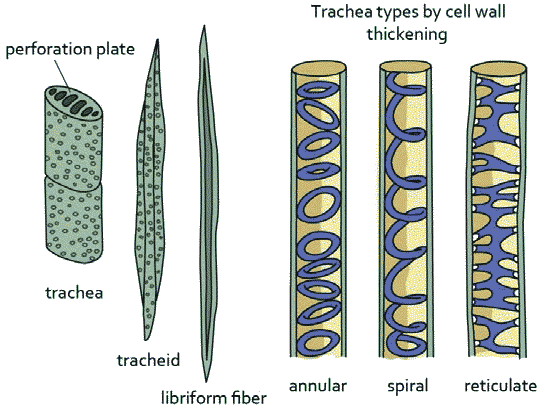 Fig. Elements of the xylem |
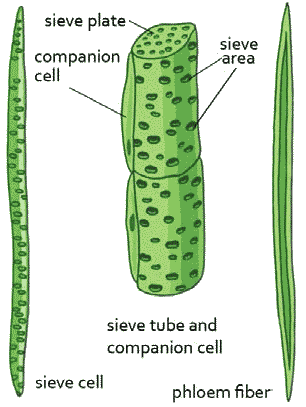
Fig. Elements of the phloem |
|
Objectives: understanding the structures of vascular bandles, based on the comparisons between monocotyledons and dicotylenons Materials (often used for training): Cucurbita moschata var. Toonas (or Cucurbita maxima) = dicotyledonae, and Zea mays = monocotyledonae
|
|
|
pl. cambia or cambiums a thin formative layer between the xylem and phloem of most vascular plants that gives rise to new cells and is responsible for secondary growth |
Water transport from rootsVessel (導管)
|
Tracheid (仮導管)developed in all vascular plantsa long and tapered lignified cell in the xylem
Fibrous tissue (繊維組織)tissue consisting of or containing fibersXylem parenchyma (木部柔組織) |
|
→ nutrient transport a) sieve tube (→ sieve plate: cell wall of phloem forms into a sheet) b) companion cell c) phloem fiber d) phloem parenchyma e) fibrous tissue f) resin canal |
PitAlternate pitBordered pit Half-bordered pit Simple pit: ramiform pit Vestured pit
|
|
= central cylinder, vascular cylinder = vascular or vessel bundle tissue + its related tissues Morphologically-various steles
seed plants → a few types Evolutionary relationshipamphipholic siphonostele (両篩管状中心柱) → dictyostele (網状中心柱)ectophloic siphonostele (多篩管状中心柱) → eustele (真正中心柱) A. protosteles (原生中心柱):are the simplest, and are often considered to be the most primitive, type of stele. Protosteles occur in Psitophyta and Microphyllophyta and in the juvenile stems of other groups (in many roots as well).
A0: concentric vascular bundle (包囲維管束): fossil records only
Ex. Psilotum sweet potato = root ↔ potato = (underground) stem A''. plectostele (背腹中心柱) Ex. Lycopodium 
e: endodermis, p: phloem, x: xylem |
B. ectophloic siphonostele (solenostele) (外部管状中心柱)
B'. amphipholic siphonostele (両節管状中心柱) C. dictyostele (網状中心柱)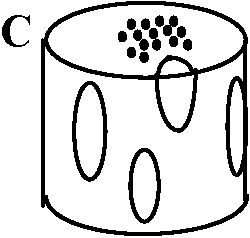 In siphonostelic stems with short internodes, overlapping of the nodal leaf gaps results in disection of the stele. As seen in transection, the stele appears as discrete strands or bundles, each surrounded by endodermis and the phloem surrounding the xylem. A siphonostele thus disected is called a dicotyostele. This type of stele characterizes many ferns.
In siphonostelic stems with short internodes, overlapping of the nodal leaf gaps results in disection of the stele. As seen in transection, the stele appears as discrete strands or bundles, each surrounded by endodermis and the phloem surrounding the xylem. A siphonostele thus disected is called a dicotyostele. This type of stele characterizes many ferns.
D. eustele (真正中心柱)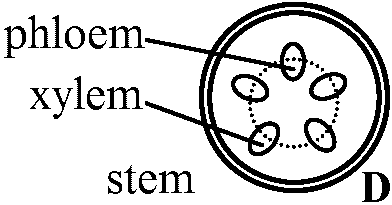 = collateral vascular bundle
= collateral vascular bundleWhere the xylem and phloem occur in discrete collateral or bicollateral strands or bundles, the arrangement is called a eustele. A eustele occurs in the internodes of Equisetum and in many gymnosperms and flowering plants. Certain of the strands pass into the leaves as traces.
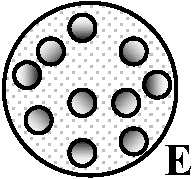
E. atactostele (不整中心柱)found in monocots, in which the vascular tissue in the stem exists as scattered bundles |
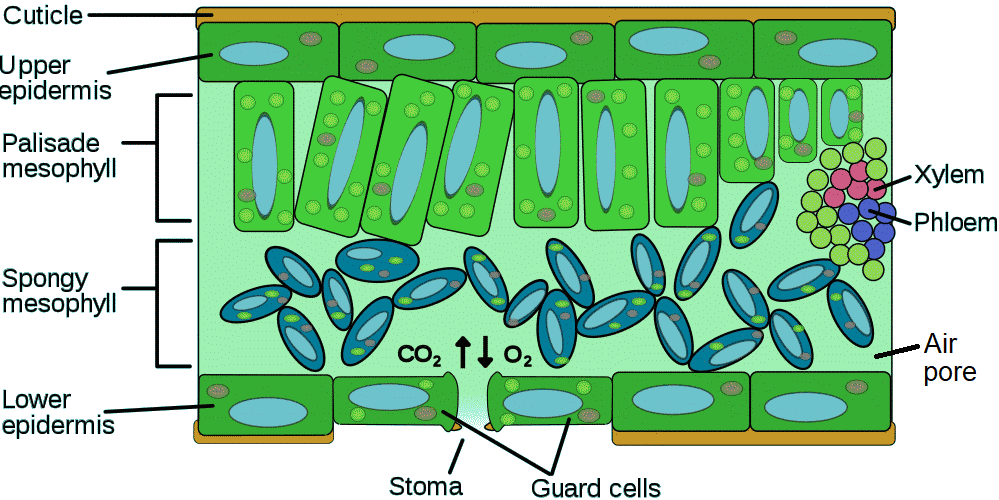
Fig. Sectoin of leaf |
cuticle
upper epidermis (上面表皮) palisade mesophyll (柵状組織) vascular bandle = xylem + phloem spongy mesophyll (海綿状組織)air pore lower epidermis (下面表皮)
stoma (気孔) (pl. stomata or stomas) Stoma (気孔) ____________Stoma open___________Stoma closed Fig. Structure of stomata |
| Root anatomy is virtually the same for monocots, dicots and gymnosperms. The vascular tissue occurs in the center, which is surrounded by two rings of cells, the pericycle and endodermis, then the cortex and epidermis. The cell walls of the endodermis that are perpendicular to the root surface (i.e.. the radial and anticlinal walls) are sealed by a suberized band (Casparian strip). Root hair is extensions of the epidermal cells. |
 [ auxin ] Root stimulator (発根促進剤)auxin (= indole acetic acid)willow: new shoot (12 cm long) with 2 leaves (Kikuchi et al. 1983)
immersed into water or 1-20 ppm NAA for 20 hours measurement: rooting ratio, root length results: S. integra 100% of rooting, of which samples are collected in March and July |